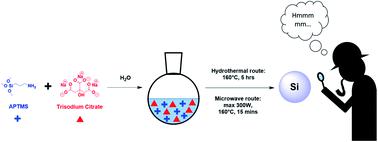当前位置:
X-MOL 学术
›
Faraday Discuss.
›
论文详情
Our official English website, www.x-mol.net, welcomes your
feedback! (Note: you will need to create a separate account there.)
Shedding light on the aqueous synthesis of silicon nanoparticles by reduction of silanes with citrates.
Faraday Discussions ( IF 3.3 ) Pub Date : 2020-01-07 , DOI: 10.1039/c9fd00127a John L Z Ddungu 1 , Simone Silvestrini , Alessandra Tassoni , Luisa De Cola
Faraday Discussions ( IF 3.3 ) Pub Date : 2020-01-07 , DOI: 10.1039/c9fd00127a John L Z Ddungu 1 , Simone Silvestrini , Alessandra Tassoni , Luisa De Cola
Affiliation

|
The synthesis of silicon nanoparticles in water has recently attracted a lot of attention. However, many scientists have expressed concerns on the nanomaterials obtained. We decided to explore two different routes to obtain silicon nanoparticles starting from a silane precursor. We report our findings regarding the preparation of nanomaterials under microwave irradiation and hydrothermal conditions starting from aqueous mixtures of (3-aminopropyl) triethoxysilane and sodium citrate. The microwave process, in particular, has been reported to yield silicon quantum dots bearing a surface layer of 3-aminopropyl moieties, allowing for the preparation of luminescent substrates amenable to biological-friendly amide chemistry. However, rigorous experimental design and thorough characterization of the products definitely rules out the formation of silicon nanoparticles. By highlighting the main issues linked to the proper characterization of these materials, we prove that the nanoparticles produced under both microwave and hydrothermal conditions, are a mixture of silica and carbon quantum dots.
中文翻译:

通过用柠檬酸盐还原硅烷,可以了解硅纳米粒子的水合成。
水中硅纳米颗粒的合成近来引起了很多关注。但是,许多科学家对获得的纳米材料表示关注。我们决定探索从硅烷前体开始获得硅纳米颗粒的两种不同途径。我们报告了有关在微波辐射和水热条件下从(3-氨基丙基)三乙氧基硅烷和柠檬酸钠的水性混合物开始制备纳米材料的发现。特别是,据报道微波方法产生了带有3-氨基丙基部分表面层的硅量子点,从而允许制备适合于生物友好的酰胺化学的发光底物。然而,严格的实验设计和产品的彻底表征无疑排除了硅纳米颗粒的形成。通过强调与这些材料的正确表征相关的主要问题,我们证明了在微波和水热条件下产生的纳米颗粒是二氧化硅和碳量子点的混合物。
更新日期:2020-01-07
中文翻译:

通过用柠檬酸盐还原硅烷,可以了解硅纳米粒子的水合成。
水中硅纳米颗粒的合成近来引起了很多关注。但是,许多科学家对获得的纳米材料表示关注。我们决定探索从硅烷前体开始获得硅纳米颗粒的两种不同途径。我们报告了有关在微波辐射和水热条件下从(3-氨基丙基)三乙氧基硅烷和柠檬酸钠的水性混合物开始制备纳米材料的发现。特别是,据报道微波方法产生了带有3-氨基丙基部分表面层的硅量子点,从而允许制备适合于生物友好的酰胺化学的发光底物。然而,严格的实验设计和产品的彻底表征无疑排除了硅纳米颗粒的形成。通过强调与这些材料的正确表征相关的主要问题,我们证明了在微波和水热条件下产生的纳米颗粒是二氧化硅和碳量子点的混合物。











































 京公网安备 11010802027423号
京公网安备 11010802027423号